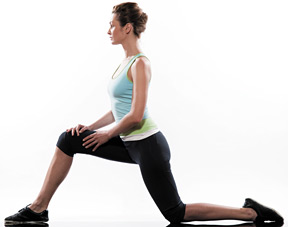Stretch Your Limits
By Editorial Staff
If you're not a regular stretcher, you might end up on one someday. We're totally serious. Without
adequate stretching, your body is much more likely to end up stiff and inflexible, particularly over time. That means you're more likely to be limited in your range of motion, and going outside of that range of motion could do damage. Here's why stretching should be a regular part of your daily wellness routine, and the best stretches to get you started.
Stretching Fundamentals
Let's consider a rubber band and a string of equal lengths. The rubber band is fairly flexible by nature, so it can stretch (within reason) to accommodate what you need it to accommodate (for example, a stack of paper). The same length of string, on the other hand, doesn't have much flexibility, if any, so if it's extended beyond its length, what happens? If it's stretched even slightly, it may start to fray; stretch it further and it will likely break (tear) into two or more pieces entirely. Bad news if that's your hamstring.
Many people exercise, but far fewer stretch. Perhaps it's because while exercise generally has visible benefits – you look better – stretching doesn't appear to do much for you on a day-to-day basis unless you're a gymnast, yoga instructor, rock climber or someone else who relies on flexibility. But that doesn't mean stretching isn't important. On the contrary; whether you're a professional athlete or a homemaker, proper stretching can help prevent injury and let you live your life to the fullest.
Benefits of Stretching
 Stretching is important for several reasons. It improves flexibility, which can come in handy whether you're reaching down to pick up a pencil from the floor, climbing a ladder to the roof or trying to grab your overeager child before they run into the street. From a sports perspective, flexibility allows you to move more easily and with a greater range of motion while reducing the odds that you'll pull, strain or overstretch something in the heat of battle. It also can protect against long-term injury, in the sense that flexibility and range-of-motion deficits can cause overcompensation patterns to develop. For example, if your hamstrings and calf muscles lack adequate range of motion, it may affect lower leg and foot mechanics, leading to tendinitis or other issues over time.
Stretching is important for several reasons. It improves flexibility, which can come in handy whether you're reaching down to pick up a pencil from the floor, climbing a ladder to the roof or trying to grab your overeager child before they run into the street. From a sports perspective, flexibility allows you to move more easily and with a greater range of motion while reducing the odds that you'll pull, strain or overstretch something in the heat of battle. It also can protect against long-term injury, in the sense that flexibility and range-of-motion deficits can cause overcompensation patterns to develop. For example, if your hamstrings and calf muscles lack adequate range of motion, it may affect lower leg and foot mechanics, leading to tendinitis or other issues over time.
Because stretching makes your body more flexible, it also has mental health benefits. First, picture yourself on the couch after a long day's work or a morning at the racquetball court, sore, stiff and in pain. Now picture yourself on the same couch after the same activities, but well-stretched, blood and oxygen circulating properly, able to achieve a superior range of motion despite your draining day. Now that's a reason to stretch, isn't it?

